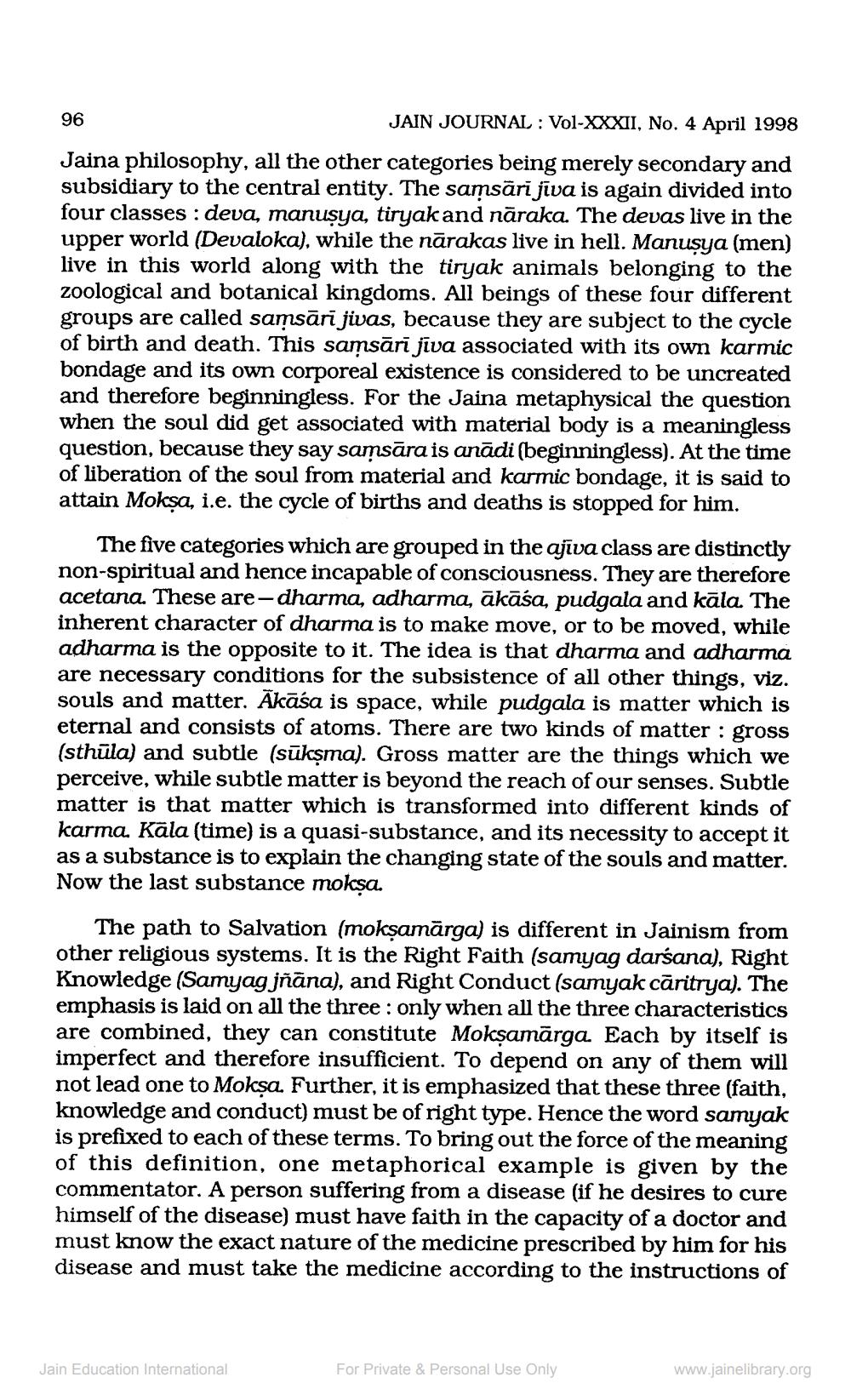Book Title: Jain Journal 1998 04 Author(s): Jain Bhawan Publication Publisher: Jain Bhawan Publication View full book textPage 6
________________ JAIN JOURNAL: Vol-XXXII, No. 4 April 1998 Jaina philosophy, all the other categories being merely secondary and subsidiary to the central entity. The samsārī jīva is again divided into four classes: deva, manusya, tiryak and nāraka. The devas live in the upper world (Devaloka), while the nārakas live in hell. Manuşya (men) live in this world along with the tiryak animals belonging to the zoological and botanical kingdoms. All beings of these four different groups are called samsārī jivas, because they are subject to the cycle of birth and death. This samsārī jīva associated with its own karmic bondage and its own corporeal existence is considered to be uncreated and therefore beginningless. For the Jaina metaphysical the question when the soul did get associated with material body is a meaningless question, because they say samsara is anadi (beginningless). At the time of liberation of the soul from material and karmic bondage, it is said to attain Mokṣa, i.e. the cycle of births and deaths is stopped for him. 96 The five categories which are grouped in the ajiva class are distinctly non-spiritual and hence incapable of consciousness. They are therefore acetana. These are- dharma, adharma, ākāśa, pudgala and kāla. The inherent character of dharma is to make move, or to be moved, while adharma is the opposite to it. The idea is that dharma and adharma are necessary conditions for the subsistence of all other things, viz. souls and matter. Akāśa is space, while pudgala is matter which is eternal and consists of atoms. There are two kinds of matter: gross (sthula) and subtle (sūkṣma). Gross matter are the things which we perceive, while subtle matter is beyond the reach of our senses. Subtle matter is that matter which is transformed into different kinds of karma. Kala (time) is a quasi-substance, and its necessity to accept it as a substance is to explain the changing state of the souls and matter. Now the last substance mokṣa. The path to Salvation (mokṣamārga) is different in Jainism from other religious systems. It is the Right Faith (samyag darsana), Right Knowledge (Samyag jñāna), and Right Conduct (samyak caritrya). The emphasis is laid on all the three: only when all the three characteristics are combined, they can constitute Mokṣamarga. Each by itself is imperfect and therefore insufficient. To depend on any of them will not lead one to Mokṣa. Further, it is emphasized that these three (faith, knowledge and conduct) must be of right type. Hence the word samyak is prefixed to each of these terms. To bring out the force of the meaning of this definition, one metaphorical example is given by the commentator. A person suffering from a disease (if he desires to cure himself of the disease) must have faith in the capacity of a doctor and must know the exact nature of the medicine prescribed by him for his disease and must take the medicine according to the instructions of Jain Education International For Private & Personal Use Only www.jainelibrary.orgPage Navigation
1 ... 4 5 6 7 8 9 10 11 12 13 14 15 16 17 18 19 20 21 22 23 24 25 26 27 28 29 30 31 32 33 34 35 36 37 38 39
